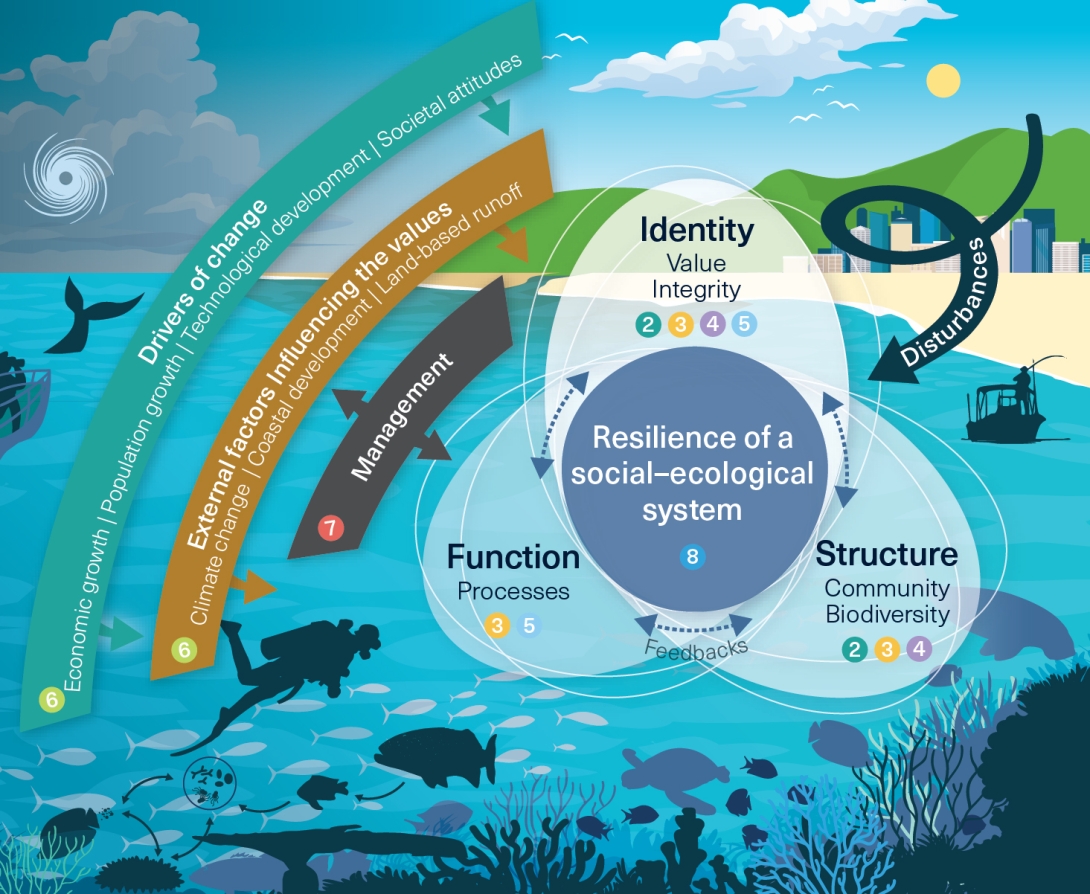The Great Barrier Reef Marine Park Authority Act 1975 (Cth) defines ecosystem-based management as an integrated approach to managing an ecosystem and matters affecting that ecosystem in which the main objective is to maintain ecological processes, biodiversity and functioning biological communities. These latter concepts are also important in the concept of social–ecological resilience (Figure 8.1), which is defined as the capacity of a system to absorb disturbance and reorganise while retaining essentially the same identity, structure, function, and feedback systems.2014 The Region is a social–ecological system in which people, species and habitats are interlinked. Therefore, resilient human and ecological communities are critical for the system’s long-term sustainability.2015
Resilient human and ecological communities are critical for the system’s long-term sustainability

Resilience is not about maintaining a single state, rather, it is a multi-dimensional dynamic process. A resilient system is an ever-changing system that has capacity to both adapt to change and to return to healthy states after a disturbance or impact. It is able to resist and/or recover from abrupt changes, or adapt to gradual ones, while maintaining its key components — i.e. its identity, including values and integrity; its structure, including communities and biodiversity; and its function, including social and ecological processes (Figure 8.1 and case study 8.5.1).1387,1397,2014 The likelihood of a system maintaining its key components and not crossing an undesirable threshold is sometimes referred to as robustness.2016
Resilience-based management is defined as ‘using knowledge of current and future drivers influencing ecosystem function to prioritise, implement, and adapt management actions that sustain ecosystems and human well-being’.1099 Both ecosystem- and resilience-based management are adaptive, focusing on maintaining connections across the social–ecological systems and managing the drivers affecting the systems. Resilience-based management additionally acknowledges that humans are capable of driving change in both social and ecological spaces, emphasising consideration of resilience to future impacts.1099 Given ongoing cumulative pressures and climate change trajectories, it is crucial to apply resilience-based Reef management in practice — by adopting additional measures to support system resistance, adaptation and recovery, and incorporating uncertainty and unpredictability. These measures are in addition to ecosystem-based management measures designed to protect values and mitigate risk.1387
Effective management can strengthen a social-ecological system’s resilience. However, it can be complex to develop tangible resilience-based management goals and translate these into meaningful management actions. While there has been increasing guidance,1099,2016,2017,2018 managers need to understand their particular social–ecological system well enough to develop location-specific tangible goals, including by defining their system’s thresholds, scales, cycles, feedback processes and domains (see also case studies 8.3.1 and 8.3.2).2019 Ultimately, resilience is about having the capacities to live with complexity, uncertainty and change, abrupt or incremental, and to continue to develop with ever-changing environments.2020
Figure 8.1
The resilience components of a social–ecological system
A resilient social–ecological system will retain its identity, values, and integrity by absorbing and/or resisting disturbances, reorganising and/or recovering its community and biodiversity structures, and maintaining and/or adapting key functions and processes. The system is depicted in different configurations, showing its capacity to change through time while the core resilience components retain their integrity. These core components can be considered at multiple spatial and temporal scales, linked by feedback processes (dashed blue lines). The system’s identity is both an emergent property of its structure and function and a definition of its values and boundaries. Resilience includes an ability to resist and/or recover from abrupt changes and to adapt to gradual ones, all of which occur within a broader environmental and social space and can be quantified with metrics such as thresholds and domains of attraction. In addition to its natural disturbance regime, the system is subject to external factors that can directly threaten its integrity. These factors are influenced by broadscale drivers of change. Resilience-based management recognises the dynamic nature of complex systems and can be adaptively targeted at different resilience components or influencing factors (e.g. case study 8.5.1). Numbered circles on the diagram link to relevant chapters in this Outlook Report.



